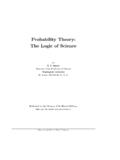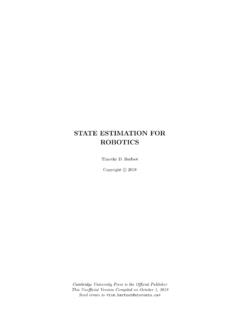Transcription of Cost Estimation - iceaaonline.com
1 cost Estimation Chapter 10. Learning Curves: Unit theory Gregory K. Mislick, LtCol, USMC (Ret). Department of Operations Research Naval Postgraduate School Learning Curve Analysis Developed as a tool to estimate the recurring costs in a production process Recurring costs: those costs incurred on each unit of production. There are no learning curves associated with overhead costs, just manufacturing costs. Dominant factor in learning theory is direct labor Based on the common observation that as a task is accomplished several times, it can be completed in shorter periods of time Each time you perform a task, you become better at it and accomplish the task faster than the previous time.
2 9 -2. ICEAA 2016 Bristol TRN 03. cost Progress cost progress (or getting better at the task ). comes from production workers' learning their tasks better, but also from: Re-design of product for lower- cost production Improved production facility and production lines Better layout / better efficiencies Management improvements Lower- cost suppliers Better make or buy decisions (produce in-house or out-source) 9 -3. Learning theory $ $ $ Unit cost $ $ $ $ 1 3 5 7 9 11 13 15. Qty 9 -4. ICEAA 2016 Bristol TRN 03. Log-Log Plot of Linear Data $ Unit cost $ 1 10 100.
3 Qty 9 -5. Linear Plot of Log Data $ $ Log Unit cost $ $ $ $ Log Qty 0 1 9 -6. ICEAA 2016 Bristol TRN 03. Learning theory Two variations: Cumulative Average theory Unit theory Note: Can only use one theory throughout an Estimation . You must be consistent! Pick one and stick with it. We will discuss why soon. 9 -7. Cumulative Average theory If there is learning in the production process, the cumulative average cost of some doubled unit equals the cumulative average cost of the un-doubled unit times the slope of the learning curve.
4 Historical Facts: Described by T. P. Wright in 1936. Based on examination of WW I aircraft production costs Aircraft companies and DoD were interested in the regular and predictable nature of the reduction in production costs that Wright observed Implied that a fixed amount of labor and facilities would produce greater and greater quantities in successive periods 9 -8. ICEAA 2016 Bristol TRN 03. Unit theory If there is learning in the production process, the cost of some doubled unit (say, unit #100) equals the cost of the un- doubled unit (= unit #50) times the slope of the learning curve.
5 Credited to J. R. Crawford in 1947. Led a study of WWII airframe production commissioned by USAF to validate learning curve theory 9 -9. Basic Concept of Unit theory As the quantity of units produced doubles, the cost ** to produce a unit is decreased by a constant percentage. For an 80% learning curve, there is a 20% decrease in cost each time that the number of units produced doubles the cost of unit 2 is 80% of the cost of unit 1. the cost of unit 4 is 80% of the cost of unit 2. the cost of unit 8 is 80% of the cost of unit 4, etc.
6 One of the few times when 80% is better than 90%. Why is 80%. better? ** The cost of a unit can be expressed in dollars, labor hours, or other units of measurement. 9 -10. ICEAA 2016 Bristol TRN 03. 80% Unit Learning Curve $ $ $ 100 $ $ 80. Log Unit cost Unit cost $ $ $ $ $ $ $ $ 0 2 4 6 8 10 12 14 16 0 1 Log Qty Qty 9 -11. Unit theory Defined by the equation Yx = A * xb where Yx = the cost of unit x (dependent variable). A = the theoretical cost of unit 1 ( T1). x = the unit number (independent variable). b = a constant representing the slope (slope = 2b).
7 This is a Power model (from Ch 9, next slide). 9 -12. ICEAA 2016 Bristol TRN 03. Some Linear Transformations Unit Log Space Model Space Y. Logarithmic Y. y = a + b ln x X ln X. b<0 Exponential b<0 ln Y. Y. Y y = a e bx ln Y. X. X b>0 b>0. X ln y = ln a + b x X. b>1 ln Y. b>1. ln Y. Y Y Power ln X. ln X. y=axb ln Y. X Y X 0<b<1. 0<b<1 ln y = ln a + b ln x ln X b<0. X b<0. 9 - 13. Learning Parameter In practice, < b < corresponds roughly with learning curves between 70% (entirely manual operations) and 96% (slope =. 2^b).
8 Learning parameter largely determined by the type of industry and the degree of automation for b = 0, the equation simplifies to Y = A, which means any unit costs the same as the first unit. In this case, the learning curve is a horizontal line and there is no learning. Not good in the business world! This is referred to as a 100% learning curve . 9 -14. ICEAA 2016 Bristol TRN 03. Learning Curve Slope versus the Learning Parameter As the number of units doubles, the unit cost is reduced by a constant percentage which is referred to as the slope of the learning curve.
9 cost of unit 2n = ( cost of unit n) x (Slope of learning curve). cost C fofi 2 unit A(2 ) 2 n b A(2 n)b Slope of learning curve 2b cost of unit n A(n)b Taking the natural log of both sides: ln (slope) = b x ln (2). b = ln(slope)/ln(2). For a typical 80% learning curve: ln (.8) = b x ln (2). b = ln (.8) /ln (2) = = slope coefficient 9 -15. General Guidelines for Slopes If an operation is 75% manual and 25% automated, slopes are generally in the 80% vicinity. If it is 50% manual and 50% automated, slopes can be expected to be about 85%.
10 If it is 25% manual and 75% automated, slopes can be expected to about 90%. The average slope for the aircraft industry is about 85%. But departments within can vary greatly from that. Shipbuilding slopes run between 80 and 85%. 9 -16. ICEAA 2016 Bristol TRN 03. General Guidelines for Slopes Assuming repetitive operations within an industry, typical slopes include: Electrical: 75-85%. Electronics: 90-95%. Machining: 90-95%. Welding: 88-92%. 9 -17. Slope and 1st Unit cost To use a learning curve for a cost estimate, a slope and 1st unit cost are required Slope may be derived from analogous production situations, industry averages, historical slopes for the same production site, or historical data from previous production quantities 1st unit costs may be derived from engineering estimates, CERs, or historical data from previous production quantities Ships Aviation 9 -18.








